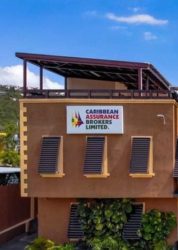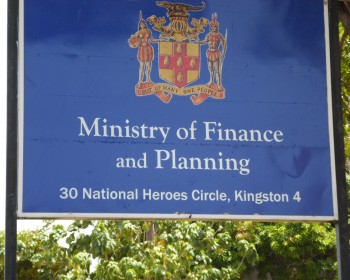 Government of Jamaica is reporting a deficit of $39 billion on its operation to February, this year, just below the $40 billion projected and a primary surplus of $79 billion versus forecast of $83 billion.
Government of Jamaica is reporting a deficit of $39 billion on its operation to February, this year, just below the $40 billion projected and a primary surplus of $79 billion versus forecast of $83 billion.
With the budget for March this year indicating expectations for a surplus of $29 billion, the country should be seeing an overall deficit close to the $11 billion reflected in the 2014/15 budget. The primary surplus budgeted at $121 billion could end up around $116 billion unless there are extraordinary inflows or sharp cut in expenditure.
Overall revenues fell $12 billion for the 11 months while there were cuts of $9 billion in capital expenditure, wages $3 billion and interest cost almost $6 billion. PAYE delivered $3 billion more inflows than forecast and withholding tax performed better than forecast by $2.5 billion. Pulling down the revenues were Local GCT $7 billion, corporation taxes $7.5 billion.
GOJ should report 2015 deficit
Jamaica’s 2014 trade deficit falls
Jamaica’s expenditure on merchandise imports during January to November 2014 fell by US$280 million or 5 percent to US$5,287 million when compared to the same period in 2013. Earnings from total exports fell by US$109 million or 7.5 percent to US$1.35 billion. The trade deficit a narrowed to by 4.1 percent or US$171 million to US$3.94 billion, compared to the similar 2013 period.
Major contributors to the fall in imports were declines of Mineral Fuels with a decline of US$154 million or 7.9 per cent, food declined by US$51 million or 5.8 per cent, to US$837 million. Chemicals fell by US$130 million or 18.6 per cent, lower imports of ethanol products were the primary contributor to this decline. Beverages & Tobacco decreased by US$66 million, US$4 million or 6.1 percent below the US$71 million recorded in the similar 2013 period.
Increased imports took place in Machinery and Transport Equipment valued at US$847 million, which grew by US$14 million or 1.7 percent and Manufactured Goods grew by US$17 million or 3.1 percent to US$561 million.
Exports|Earnings from traditional exports increased up by US$19 million or 2.7 percent to US$739 million, due to increases in Mining and Quarrying but Non-Traditional domestic exports valued at US$549 million, fell 16.9 percent or US$111 million.
Remittances top $2.16b in 2014
 Remittance inflows for 2014 exceeded the amount earned by Jamaica in 2013 by US$95 million or 4.6 percent, according to data released by Jamaica’s Central Bank.
Remittance inflows for 2014 exceeded the amount earned by Jamaica in 2013 by US$95 million or 4.6 percent, according to data released by Jamaica’s Central Bank.
The country saw total inflows of US$2.16 billion for the January to December period. The total flows are likely to be just under the $2.2 billion estimated inflows from the tourism sector for 2014.
Net remittances for 2014 were US$1.93 billion, representing a growth of US$102 million or 5.6 percent compared to 2013 and emanated from an increase in gross inflows and a reduction of outflows.
The increase in total remittance inflows reflected an increase of US$95 million in inflows through Remittance Companies. This increase was however partly offset by a decline of US$0.5 million in inflows from the Other Remittances sub-category.
Treasury bills rates mostly fall
Interest rates are down on the latest issue of treasury bills compared with the out turn in February, for the three and six months instruments but the 28 days instrument enjoyed a slight increase compared with the rate at the February auction.
 The 182 days bill ended with an average rate of 6.99 percent and is back to the level at the January auction. The highest rate allotted for the latest issue is 7.16 percent, while $948 million chased after the amount offered.
The 182 days bill ended with an average rate of 6.99 percent and is back to the level at the January auction. The highest rate allotted for the latest issue is 7.16 percent, while $948 million chased after the amount offered.
The 91 days instrument attracted bids for $720 million and resulted in an average rate of 6.3 percent with 6.8 percent being the highest rate allotted. The average rate for the February auction came in at 6.88 percent.
The 28 days instrument attracted bids for $655 million and resulted in the average rate being 6.7278 percent with the highest rate allotted being 6.9 percent. The average rate for the February auction was 6.417 percent.
All three auctions had $400 million each on offer to the public.
GOJ has $15 billion hole in budget
Notwithstanding the good news for January, Phillips budget has a $15 billion gap between the revenues and recurrent and non-debt capital expenditure to be filled, if the government is to have another year of balanced fiscal operations. The situation can get worse if Phillips aggressive take on GCT and PAYE inflows don’t materialize. These two areas seem likely to underperform forecast, while corporate taxes could do far better that projections.
The government is projecting to collect around 5.5 percent more in revenues than for the year ending in March on the assumption that the short fall in revenues to January will be maintained at those levels. The 2014-15 budget projected revenues at $428 billion but it should end around $420 billion when the numbers are all in. the next fiscal year projection is for revenues of $448 billion. The projection for tax revenues is an increase of 7.5 percent to reach $402 billion from around $374 billion.
PAYE is to make a big jump of 13 percent to get to $76 billion from around $67 billion, for the March 2015 fiscal year. But while the government is projecting a huge increase in PAYE there is slower growth for education of tax, projected at $21 billion, up from $19 billion or 10.5 percent. Under normal circumstances education taxes should grow faster than PAYE in this fiscal year. The threshold for Income tax has been increased and would therefore mean that the PAYE would be paid on a smaller sum than for Education tax. GCT is projected to jump by $17 billion to $139 billion, a high 14 percent increase. Surprisingly, Corporation taxes are projected to enjoy no increase. That is a big surprise with a large portion of cost input this year having fallen significantly and should help improve companies bottom-line. The other element is that those lower energy cost for fuel and electricity will boost consumer spending somewhat and that will feed back into corporate profits, as such businesses should benefit in two ways.
Banking on a sharp increase in GCT and PAYE are inconsistent with an economy that projected to grow at no more than 2 percent in real terms and nominally, possibly 5-6 percent and an assumption that corporate taxes will be fall is inconsistent with the impact of the falling prices of electricity, gasoline and interest rates on profits.
Projected payments on recurrent expenditure is for $433 billion and capital expenditure of $29 billion and leaves a shortfall of $15 billion.
GOJ intake ahead for January
 The government of Jamaica enjoyed increased inflows into their coffers in January, bringing the total to $34.4 billion, $1.4 billion more than the $33.2 billion projected. The major area contributing to the improvement is tax on interest delivering $1.2 billion more than forecast.
The government of Jamaica enjoyed increased inflows into their coffers in January, bringing the total to $34.4 billion, $1.4 billion more than the $33.2 billion projected. The major area contributing to the improvement is tax on interest delivering $1.2 billion more than forecast.
The intake took the 10 months revenues to $322 billion down by $8.6 billion, just 2.6 percent short of estimates. The major contributors to the year to date shortage is corporate taxes, down $7 billion and production and consumption taxes on local goods and services down by $7.3 billion. Out-performing the target set are, PAYE, non-tax revenues and taxes on interest.
Payments are down, with capital spend coming in at $10.3 billion below projection, interest cost is $5.6 billion lower than originally projected due no doubt to lower interest rates, wages spend is $2.6 billion less than forecast and other expenditure is up by $3.3 billion. The fiscal deficit came in at $6.5 billion ahead of target and the primary surplus at $76 billion is just slightly ahead of target.
The data suggests that the fiscal deficit originally projected at $11.4 billion is likely to end at less than $4.5 billion for the fiscal year.
BNS dumps US$19m in 2 days
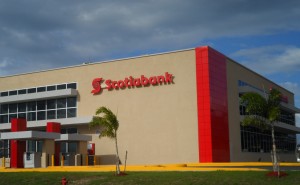 Bank of Nova Scotia (BNS)
Bank of Nova Scotia (BNS)
bought just US$3.9 million on Friday but sold US$17.8 million. On Thursday BNS sold US$12.6 million compared buying of only US$7.97 million, resulting in a net sale of US$19 in the two days.
On Thursday, National Commercial Bank (NCB) also sold more than they bought, with buying accounting for $6 million and selling US$10.5 million. NCB’s trade on Friday, was more balanced, with selling of just US$1 million more than they bought. While Scotia’s average selling rate was $115.70 on Thursday, on Friday it fell to $115.57, in contrast NCB’s average selling rate on Friday was $115.75 and $115.69 on Thursday.
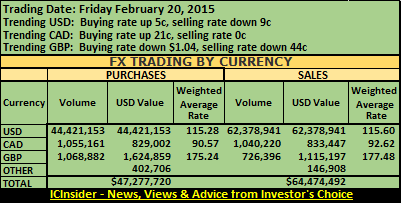 There was more selling than buying of foreign currencies by dealers on Friday, with purchases of all currencies amounting to US$47,277,720 compared with US$42,778,081, on Thursday. Selling was the equivalent of US$64,474,492 versus US$52,219,662 sold on Thursday.
There was more selling than buying of foreign currencies by dealers on Friday, with purchases of all currencies amounting to US$47,277,720 compared with US$42,778,081, on Thursday. Selling was the equivalent of US$64,474,492 versus US$52,219,662 sold on Thursday.
In US dollar trading, dealers bought US$44,421,153 compared to US$38,951,367 on Thursday. The buying rate for the US dollar climbed 5 cents to $115.28 and US$62,378,941 was sold versus US$49,786,691 on Thursday, the selling rate dropped 9 cents to $115.60. The Canadian dollar buying rate climbed 21 cents to $90.57 with dealers buying C$1,055,161, and selling C$1,040,220, at an average rate that remained unchanged at $92.62. The rate for buying the British Pound dropped $1.04 to $175.24 for the purchase of £1,068,882, while £726,396 was sold, at an average rate of $177.48, down by 44 cents. At the end of trading it took J$131.77 to purchase the Euro, 35 cents more than on Thursday, according to data from Bank of Jamaica, while dealers purchased the European common currency at J$129.28 for 34 cents over the rate on Thursday. Other currencies bought, amounted to the equivalent of US$402,706 while the equivalent of US$146,908, was sold.
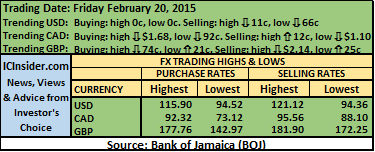 Highs & Lows| The highest buying rate for the US dollar and the lowest buying rates remained at $115.90 and $94.52 respectively. The highest selling lost 11 cents to $121.12. The lowest selling rate fell 66 cents to $94.36. The highest buying rate for the Canadian dollar fell $1.68 to $92.32, the lowest buying rate dipped 92 cents to $73.12. The highest selling rate rose 12 cents to $95.56 and the lowest selling rate lost $1.10 to $88.10. The highest buying rate for the British Pound, dropped 74 cents to $177.76. The lowest buying rate climbed 21 cents to $142.97, the highest selling rate dropped $2.14 to $181.90 and the lowest selling rate was up 25 cents to $172.25.
Highs & Lows| The highest buying rate for the US dollar and the lowest buying rates remained at $115.90 and $94.52 respectively. The highest selling lost 11 cents to $121.12. The lowest selling rate fell 66 cents to $94.36. The highest buying rate for the Canadian dollar fell $1.68 to $92.32, the lowest buying rate dipped 92 cents to $73.12. The highest selling rate rose 12 cents to $95.56 and the lowest selling rate lost $1.10 to $88.10. The highest buying rate for the British Pound, dropped 74 cents to $177.76. The lowest buying rate climbed 21 cents to $142.97, the highest selling rate dropped $2.14 to $181.90 and the lowest selling rate was up 25 cents to $172.25.
Treasury-bill rates up
Interest rates on government of Jamaica latest Treasury bills auction rose for the first time since peaking in March last year. The three offerings at the February 20 auctions, resulted in a rise in rates for the 28 days and the 182 days notes, while the rate on the 91 days Treasury bill declined moderately.
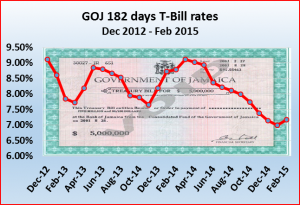 The 182 days note closed at 7.164 percent, an increase from 6.99 percent at the January auction. The rate for the 91 days Treasury bills fell to 6.8796 percent, slightly down from of 6.8817 percent in January, while the rate on the 28 days ended at 6.417 percent up, from 6.295 percent at the January auction.
The 182 days note closed at 7.164 percent, an increase from 6.99 percent at the January auction. The rate for the 91 days Treasury bills fell to 6.8796 percent, slightly down from of 6.8817 percent in January, while the rate on the 28 days ended at 6.417 percent up, from 6.295 percent at the January auction.
The change in the movement is consistent with the slowing pace of change at which the 182 days treasury rates were falling, having slowed from 0.34 percent dip in November to 0.15 percent at the January issue.
With Bank of Jamaica’s projection for inflation in 2015, in the range of 3-5 percent and with inflation for January coming in at negative 0.5 percent, its unlikely that the latest increase in the rates will last for too long, as there will be lots of room for the treasury rates to decline sharply in the months ahead.
All three instruments offered, were for $400 million each, with demand for the 28 days instrument amounting to $690 million versus $1.15 billion in January. The 91 days instrument attracted $1.298 billion up from $706 million in January and the 182 days instrument pulled in $822 million up from $717 million at the January auction.
Inflation drops again says Statin
 The Statistical Institute of Jamaica (Statin) reports that the All Jamaica ‘All Divisions’ Consumer Price Index fell by 0.5 percent in January this year, the third consecutive monthly decline in the inflation rate for Jamaica. The inflation rate was 0.1 percent in October, November was negative 0.5 percent and December negative 0.3 percent. The downward movement in inflation for January was mainly attributable to a fall in the index for the three highest weighted divisions. The index ‘Food and Non-Alcoholic Beverages’ fell by 0.2 percent, followed by the division ‘Housing Water, Electricity,
The Statistical Institute of Jamaica (Statin) reports that the All Jamaica ‘All Divisions’ Consumer Price Index fell by 0.5 percent in January this year, the third consecutive monthly decline in the inflation rate for Jamaica. The inflation rate was 0.1 percent in October, November was negative 0.5 percent and December negative 0.3 percent. The downward movement in inflation for January was mainly attributable to a fall in the index for the three highest weighted divisions. The index ‘Food and Non-Alcoholic Beverages’ fell by 0.2 percent, followed by the division ‘Housing Water, Electricity,
The release went on to state that the divisions that recorded increases in the All Jamaica ‘All Divisions’ index were: ‘Alcoholic Beverages and Tobacco’ 0.4 percent, ‘Clothing and Footwear’ 0.9 percent, ‘Furnishings, Household Equipment and Routine Household Maintenance’ 0.3 percent, ‘Health’ 0.1 percent, ‘Recreation and Culture’ 0.1 percent, ‘and ‘Miscellaneous Goods and Services’ 0.6 percent, while Restaurants and Accommodation Services’ 2.5 percent, ‘Education’, and ‘Communication’ each remained unchanged.
Jamaica’s economy barely delivering jobs
The slow growth in the numbers on newly employed is a direct result of the low growth performance in the local economy as current government policy drives down demand for many goods and services in the country as government maintains the target of a balance fiscal operation.
Statin said the unemployment rate for males declined from 10.6 percent to 9.9 percent and for females from 20.0 percent to 19.4 percent.
 “The number of persons in the Labour Force was 1,310,700, an increase of 6,200 (0.5 percent) above the 1,304,500 recorded in September 2013” Statin said.
“The number of persons in the Labour Force was 1,310,700, an increase of 6,200 (0.5 percent) above the 1,304,500 recorded in September 2013” Statin said.The number of persons employed according to the latest data for 2014 is 1,124,500 persons, 14,000 (1.3 percent) more than the 1,110,500 recorded in September 2013, the report indicated. The composition continues to show much more male employment than female, with 645,900 males and 478,600.
According to the report the largest increases in the number of employed persons occurred in the groups ‘Wholesale & Retail, Repair of Motor Vehicle & Equipment’ and ‘Agriculture, Hunting, Forestry & Fishing’. The number of persons employed in the group ‘Wholesale & Retail, Repair of Motor Vehicle & Equipment’ increased by 11,700 (5.5 percent) while the group ‘Agriculture, Hunting, Forestry & Fishing’ increased by 7,800 (3.9 percent).
- « Previous Page
- 1
- …
- 489
- 490
- 491
- 492
- 493
- …
- 497
- Next Page »







